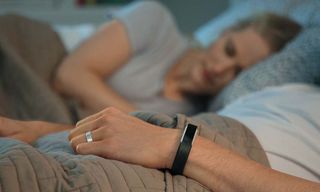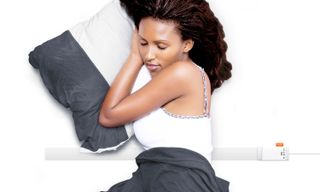Do Sleep Tracking Devices Really Work?
From wearables to in-bed gadgets, tech for sleep monitoring is getting smarter, but the devices' overall effectiveness varies.

Bad sleep is the new boogeyman, threatening the overstimulated, overworked masses with disease and even an early death. Numerous scientific studies from researchers around the world have demonstrated the harmful effects of sleep deprivation on human health. When stress levels go up, people gain weight and forget things. Without shut-eye, the body doesn't have a chance to produce enough growth hormones to build itself back up.
Recently, a number of wellness-targeted and activity-tracking consumer devices have expanded to include sleep tracking. They promise to reveal what actually happens when your eyes are shut. But are those data accurate and, more importantly, useful?

Most of these commercial devices are well intended, said Dr. Stuart Quan, a senior physician and clinical director in the Division of Sleep and Circadian Disorders at Brigham and Women's Hospital and a sleep medicine professor at Harvard Medical School. "But for the most part, they're not well studied," he said.
Tech that has been approved for use in laboratories includes the classic polysomnography test (PSG) to diagnose sleep disorders. A patient dons dozens of different wires, and must fall asleep while the equipment monitors the person's heart rate, breathing, movement, blood oxygen level and brain waves.
Consumer devices bring some of that lab-level tracking into the home — without the bulk. The catch: Most of them haven't undergone rigorous scientific study or jumped through regulatory hoops. So, then, the big question is whether they're effective at tracking sleep quality and improving the problems they detect.
Just like finding the perfect pillow, successful sleep tracking hinges on individual preferences.
More: Five Surprising Sleep Discoveries (LiveScience)
Wearables Step It Up
Most consumer wrist-worn sleep trackers use technology called actigraphy, Quan explained. This noninvasive method for measuring rest relies on accelerometers to detect the wearer's position and movement.
Dr. Matthew Diamond, a sports medicine physician, scientist and the medical director for Misfit, said the company's wrist-worn tracker Shine uses an accelerometer. "That sensor is able to detect when you're walking," he said. "It's also able to detect when you're lying in bed sleeping."
Diamond called wearables an important window into wellness and a helpful way for users set goals. Misfit initially focused on measuring daytime physical activities and then added sleep monitoring, he said. Now the company's wrist-worn devices — such as the Shine ($69.99), Shine 2 ($99.99) and Flash ($29.99) — gather sleep data overnight through their sensors. Most Fitbit devices ($99.95 to $249), Garmin's activity trackers ($99 to $249) and all Jawbone fitness trackers ($49.99 to $199) also rely on motion detection.

Several wrist-worn devices — such as the Jawbone Up3 ($99.99), the Fitbit Charge HR ($149.99) and the Garmin vívoactive HR ($149.99) — also can measure heart rate to help determine when the wearer is asleep. While these sensors can be reasonably accurate, they still can't compare to the analysis done in a sleep lab, Quan said.
Paul Kelley, a clinical research associate in the Sleep and Circadian Neuroscience Institute at the University of Oxford, noted that sleep labs have the advantage of measuring circadian rhythms. Labs also can test for important factors like core body temperature, brain activity and hormone levels, he said.
MORE: Best Fitness Trackers For Activity & Sleep
Kelley theorizes that trackers intended for consumers can be good indicators of a person's sleep, even if they don't have the same capabilities as a lab. "The data that comes out is probably in the right ballpark about duration," Kelley said. "It may be less clear about quality of sleep."
"We're still a long way off from getting a full idea of sleep from these wearables." – Colin Shapiro, unit program director at Toronto Western Hospital's Sleep Research Unit
The biggest sleep-tracking challenge for these do-it-all bands is accuracy, experts say. For example, some of these devices will mistakenly identify someone as sleeping when they're actually awake, or may think a quiet TV watcher has nodded off.
"We're still a long way off from getting a full idea of sleep from these wearables,” said Colin Shapiro, a professor at the University of Toronto and program director for the Sleep Research Unit at Toronto Western Hospital."They might be a rough guide, but they're certainly not telling the whole story."
In-Bed Tech
People who are looking to gather more comprehensive, accurate data will need to tuck technology right into their mattress. Starting with a system for hospital beds, EarlySense's Food and Drug Administration-approved device detects three types of body vibrations: large body movement similar to what wearables pick up, chest motion from breathing and cardioballistic effect — a small but clear recoil within the whole body when the heart compresses.

"We ran clinical trials to check whether we can measure accurately sleep with our sensor," said Avner Halperin, CEO of EarlySense. Initially, the technology was used in hospitals, but over the past two years, the company has partnered with Samsung, German health products manufacturer Beurer and fitness technology company iFit to manufacture devices for consumers. The Samsung SleepSense device, which analyzes sleep quality and produces personalized reports, is expected to retail in the $200 to $250 range. The company has yet to announce a product release date.
Samsung will join the Emfit QS ($299) and the Withings Aura Connected Alarm Clock and Sleep Sensor ($299), which both go underneath a mattress for contact-free tracking. The Emfit QS measures heart rate variability, physical activity and breathing. Similarly, the Withings system tracks body movement, breathing cycles and heart rate for analysis.
"Optimizing temperature according to different phases in sleep can actually significantly improve sleep quality." – Avner Halperin, CEO of EarlySense
Misfit also makes the Beddit Sleep Tracker ($149.95) that goes on top of a mattress, under the sheets. The thin device relies on ballistocardiography (BCG), a technique that measures the body's slight recoil from heartbeats, to record details about the duration and depth of sleep.
Kelley said consumer-oriented tracking devices are on the road to helping people improve their sleep but they haven't arrived yet. "You've got an intermediate technology between what you'd like ideally, and what you've got on your wrist — or bed," he said.
Smarter Conditions for Better Sleep
Once you know that you're not getting a good night's sleep, what can you do about it? Instead of merely offering tips like "take a nighttime shower" and "leave the blinds open for morning light," device makers are developing ways to optimize physical conditions by automatically adjusting lighting, sounds and room temperature.
Many of the top wrist-worn fitness trackers include the option to set a smart alarm that senses when the wearer has gone into a light sleep state. At that point, the device will start to vibrate for a gentle wake-up.

The Withings Aura alarm clock, for example, aims to wake users at the best time in their sleep cycles. The clock has a dynamic glowing LED light that simulates sunset and sunrise with colors the company says promote the production of sleep hormones. The device tracks luminosity and ambient noise to show what could have prompted a wake-up in the middle of the night. It's also compatible with the Nest Learning Thermostat, so the room stays comfortable.
Samsung's SleepSense device can automatically turn off a Samsung smart TV when it detects you've fallen asleep.
Likewise, Samsung's SleepSense device can connect to the company's smart appliances. That means that, when the device detects that you've fallen asleep, it can automatically turn off a Samsung smart TV. SleepSense also connects to the Samsung SmartThings app and hub, which work with hundreds of smart devices, including lights and thermostats. "Optimizing temperature according to different phases in sleep can actually significantly improve sleep quality," Halperin said.
Even closer to the body's core is the Nuyu Sleep System ($499), a Bluetooth-connected sleep mat with water-filled tubes that change temperature during the night to mimic circadian rhythms.

An algorithm that works with a wearable activity tracker warms the mat to prompt sleep, cools during the night and warms back up in the morning. Users set a wake-up time or how long they want to sleep, and the system creates the cycle.
Bottom Line: The Limits of Tech
At a minimum, trackers can confirm what the sleepless already suspected, and then share that data with their doctors, Quan said. From his perspective, though, the biggest step toward improving sleep is to aim to get at least 7 hours, the minimum amount that the American Academy of Sleep Medicine and the Sleep Research Society recommend for adults.
We have our sleep routines, for better or for worse. "For the most part, people can make choices about whether they allow enough time for sleep," Quan said.
When shifting bedtime habits seems too difficult, smart devices could provide enough of a nudge in the right direction. But even the device makers say not to expect their technology to be a magic pill. Perfect, restful sleep doesn't just happen overnight.

Tom's Guide to Fitness Tech
Sign up to get the BEST of Tom's Guide direct to your inbox.
Get instant access to breaking news, the hottest reviews, great deals and helpful tips.
